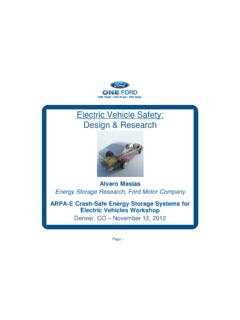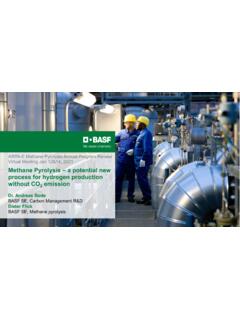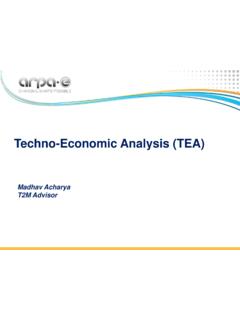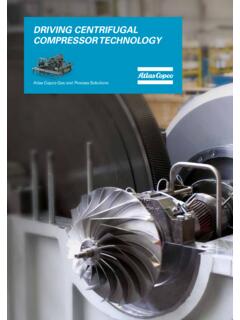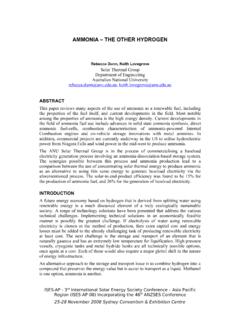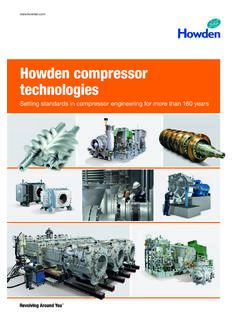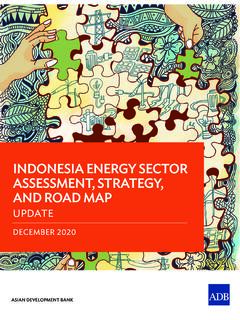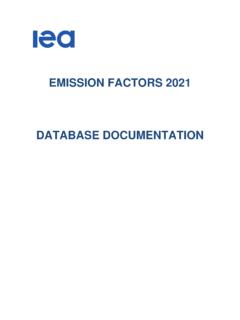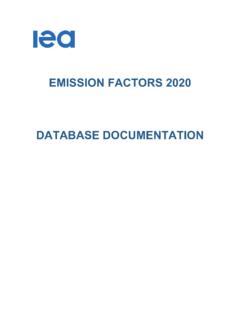Transcription of Ammonia Fuel Opportunities, Markets, Issues - ARPA-E
1 Ammonia FuelOpportunities, Markets, IssuesDr. Steve WittrigSenior Advisor, Advanced Energy SystemsClean Air Task Force Prize 21st Century(With Apologies to Daniel Yergin)A zero carbon fuelThat can be used for transportation and power generationThat is scalable from global chemical to global energy proportionsThat is an inherently clean fuel with regard to traditional pollutants and CO2 That has a century long history of large scale handling and useThat is competitive in energy pricing to current fuelsThat holds promise for low or no carbon production (through CCS on standard technology or advanced technology for renewables or nuclear)That appears to bewithin easy reach through optimization of production, use and safety regulations2 What We Know Ammonia average price over last 20 years is $300 per tonne. Equivalent to $ gal gasoline and $14 per MMBTU LNG. power at $ per kwh (@45% efficiency) Ammonia can be produced from zero carbon energy (hydro, nuclear, wind) and with significantCCS at lowest cost of capture for any hydrocarbon process Ammonia diesel engines are proven and essentially equivalent in cost (either with diesel blending, precracking or advanced engines) Ammonia turbines with precrackingto produce hydrogen for component of the fuel are efficient and flexible In general, these technologies have considerable headroom and are primarily in need of engineering optimization and field prototyping for commercialization3 Low Carbon Ammonia (And Front End For CCS) Ammonia plants emit pure (sequestration-ready) CO2.
2 Approximately 2/3 is pure. With current technology, the rest is flue gas from the reformer. There are active markets to purchase CO2for enhanced oil recovery. Ammonia plants built close to EOR fields can sell their waste CO2to be sequestered in oil fields after use. EOR technologies exist for complete CO2 sequestration at low incremental cost. (co-injection with N2) This co-product value can reduce production cost for eventual fuel use. These operations will also supply a great deal of experience, technology and infrastructure for carbon capture and for CO2transportation and sequestration. This will serve as a bridge while green Ammonia technologies from renewables, hydro and nuclear energy are optimized for a decarbonized Ammonia energy system for power and for liquid fuel for Carbon AmmoniaAs a Basis for Affordable, World Scale Zero Carbon Energy Decarbonize the giant gas reserves. Initially, pure CO2 injection for miscible EORce. Separate injection points of CO2 flue gas for immiscible pressure maintenance.
3 Injection continues into reservoir following oil production and into adjacent reservoirs. Renewable energy (wind, solar, hydro, geothermal) and nuclear to produce Ammonia from water and air. Electrolysis to H2 and Haber Bosch Ammonia in development at prototype stage potentially $400 per tonne on technologies in development. Solid State Ammonia Synthesis (SSAS) also in the same range. Fundamental point. Ammonia is the simplest molecule that stores hydrogen in a liquid form at near ambient generation -NH3 Diesel Engines One of the most promising early applications for Ammonia as a fuel is large stationary diesel gen sets. (nominally 40-45% efficient for power , 75% for CHP). Sturman engines as prototype. There are over 200 GW of medium to large diesel engines that run on a continuous basis producing electricity. These installations often feature a dozen or more engines installed in a kind of modular power plant . These modular power plants can be installed very quickly, scaled up or added as necessary, and redeployed when not needed or if the economic conditions change.
4 Gas Turbines. Crack some of the NH3 to produce arbitrary amount of H2 for co-feed with NH3 (tunable fuel, exhaust heat recovery). SPG Fuel Cells. Ideal fuel for SOFCs. Ideal hydrogen storage and delivery for PEMFCs and FCVs Space heating, Process heat (similar to LPG). Ideal for CHP from Points For Transportation There are several entrepreneurs and institutions that are advancing the technology of engines for Ammonia fuel. Toyota is developing a technology and patent portfolio for Ammonia engines including onboard cracker for tunable addition of hydrogen. +Nakamura&q= Ammonia +engine Jay Schmueckerhas developed a system to manufacture Ammonia from solar and a tractor to run on the Ammonia . Sturman Industries is developing Ammonia engines based on advanced concepts in valves, camlessengines and injection strategies. The Iowa Energy Center is developing engine technologies for use in agricultural industry. + Ammonia +engine&sa=Search&sa=Search Greg Vezina has developed Ammonia vehicles on standard platforms.
5 From all appearances, these are well developed prototypes. https:// (Hydrofuel, )7 global Sources - Overview Alaska North Slope US Southwest/Midwest/Fracking in general Middle East / North Africa (lowest cost Ammonia currently, lots of headroom) Canada Hydroelectric (10 s of GW of low cost power on contract) Iceland (practically unlimited geothermal at ~3 cents/kwh) Big Wind (depends on low capex electrolysis tech, allows local grid stabilization) Off Peak Nuclear (depends on low capex electrolysis tech, allows local grid stabilization)8 global Markets - Overview Alaska (displace diesel across the state, supply Anchorage, alternate export market for Alaska gas) Hawaii (displace diesel, residand gasoline across the islands; CHP and distributed generation ) Northeast/MidAtlantic(energy security, grid stability, alternative to gas) Midwest (energy security, grid stability, displace fuel oil/LPG, fertilizer) Caribbean (displace diesel, residand gasoline across the islands) Japan (alternative to expensive LNG and coal, replacing nuclear) Indonesia (displace diesel, residand gasoline across the islands) China (clean cities, rural access, much easier than gas) Europe (energy security, CHP, DG, fertilizer/fuel) Africa, South America ( Ammonia diesel gen, clean cities, rural access)9 A typical high volume gasoline station can easily dispense MM gallons of multiple grades of gasoline/diesel in a year.
6 This case examines a neighborhood Ammonia energy station of approximately the same scale that could provide power and heat to the neighborhood (or condo or office building) in an urban environment. This station would house a diesel genset/CHP unit running on Ammonia . The prototype for this is the MHI MegaNinja gas genset(delivered on 40 trailer, MW generator operating at efficiency, designed for combined heat/ power taking efficiency up to 75% for medium pressure steam/space and water heating and adsorptive air conditioning.) The general complexity of these stations would be less than a gasoline station (single grade, dispensed almost entirely to the generators instead of retail interface with hundreds of transactions to untrained public per day). Tank volume, general regulatory requirements and fuel delivery logistics would be similar. The average weekly volume would be about 35,000 gallons. We can design for 40,000 gal/week peak usage. A typical tank size for Ammonia distributors is 30,000 gallons.
7 So, with one 30,000 gal tank (installed underground for safety, security and ease of temp/pressure maintenance), we could operate with three a week deliveries from 11,500 gal tank trucks (typical size Ammonia trucks). I m sure the logistics can/will be optimized beyond that, but this will do for illustration. Very rough project costs would be about $ MM for Ammonia MegaNinja, $ MM for underground tank, connections and land. Roughly $ $2 Energy Station Upside revenue potential for similar projects in other regions of the world. Examples: Island economies that must generate their power from fuel oil (Hawaii, Caribbean, Indonesia). Fuel oil is $30-$40 per mmbtu. It is dirty and must be located away from populations (and especially resorts). That also makes it very difficult to capture and utilize the 1/3 of the btu sfrom CHP that clean Ammonia engines can provide. These units can provide clean power at less than half the cost and, on top of that, very efficient heat and air conditioning (absorptive chilling).
8 Medium scale distribution/retail (frozen/refrigerated foods), light industry and agriculture utilizing refrigeration, medium pressure steam or drying ( , crops) that place high value on the associated heat) Regions that place high value on pure water (exhaust from Ammonia Sturman engine is water and nitrogen. Pure water can be captured at the cost of condensing the water.) Combustion of MM gallons of Ammonia generates about MM gallons of water. They will be very attractive to sites willing and able to pay large premiums for locally controlled, uninterruptible power (financial/business centers, server farms, hospitals, military/government installations, large research facilities/research universities) Regions that are imposing a cost on CO2 emissions can reduce or eliminate those costs. Clean power Plan. Grid ancillary services. Load following, Peak power , Voltage/frequency regulation, Locational value, Black start11 Neighborhood Energy StationAmmonia GensetSturman , heat, coolingDC LoadsNeighborhood Energy Station Ideal Energy Station can be installed at highest locational value Highest leverage to stabilize grid, relieve congestion and defer infrastructure investment With a set up like Ideal power , this configuration can Easily accommodate renewable solar or wind by cutting back genset(with immediate local load following).
9 Pass through solar/wind or Ammonia power and ancillary services to the grid. 24/7 availability of peaking power (125% of gensetrating typical), frequency regulation, voltage support, black start. Provide predictable, addressable standby reserve available on 5 minute call-up (with right incentives and minimally sophisticated smart grid controls) (much cheaper and much more flexible than spinning reserve CCGT that is only used as gas prices are rising above $40/mmbtu) Provide distributed and potentially very substantial regional fuel reserve for mid-winter, late summer, regional security (much cheaper (pseudo- free ) than natural gas storage and much more flexible). 30,000 gallon underground tank of Ammonia provides about 180 MWh of electricity (42%) and 400 MMBTU of CHP heat (30%), About 5 days of continuous Energy StationHow Does This All Get Started? Market demonstration at 1-10 MW scale (diesel gen, refit, new optimized, blends) Sturman engines, Fleming Ammonia , others Evaluation of these systems for zero carbon power across the value chain by experts and system modelers Engage regulators and power industry Engage Ammonia producers/investors New build guaranteed offtake (some fraction of production) Eventually, utility plants with guaranteed returns for fuel take or pay (with perhaps shared profits for joint sales into market after satisfaction of energy market contractual requirements) Market, regulatory, technology demo support from self selected producers Plant technology/engineering firms (KBR, Uhde, MHI, etc)
10 That will benefit from increased building Low cost, high CO2 value areas for low carbon, low cost fuels Accelerate demo/commercialization of power to NH3 technologies Compile list of potentially interested investors, green funding, etcfor incipient technologies for investments in the range of $5-$20 MM for FEED, critical demoes or initial deployment in regions for low cost stranded power ( , Canada, Iceland, Hawaii) Competition for proposals for Ammonia from power , perhaps with funding from such entities Project development with engaged stakeholders16 Backup Slides17 Indicative Economics - Overview New world scale plant, 1 mm tonnes/year @ $1200 per tonne of annual capacity. 10% annual capital charge about $120/tonne Approx. 30 mmbtu of gas required per tonne of Ammonia ( , $4/mmbtu gas, about $120/tonne of Ammonia )18 to Battery Storage Much lower cost, 30,000 gal underground tank (similar to gas station) stores about 180 MWh and 400 MMBTU CHP heat.

